Scenes from Queens: Stefanos Tsitsipas, Simona Halep shocked by qualifiers Daniel Galan and Daria Snigur; more from US Open's Day 1
By TENNIS.com Aug 29, 2022Eric Butorac will replace Stacey Allaster as US Open tournament director
By Associated Press Nov 17, 2025Beyond The Champions: 2025 US Open Winners and Losers
By Peter Bodo Sep 10, 2025In US Open defeat, Jannik Sinner faces his shortcomings
By Pete Bodo Sep 09, 2025Amanda Anisimova's US Open fortnight wasn't just "incredible"—it was redemptive
By Pete Bodo Sep 09, 2025Overcoming Doubt, Finding Deliverance: Six WTA takeaways from the 2025 US Open
By Joel Drucker Sep 08, 2025Service and a smile: How Carlos Alcaraz conquered Jannik Sinner at the 2025 US Open
By Steve Tignor Sep 08, 2025Carlos Alcaraz captures sixth Slam and second US Open title, dethrones No. 1 Jannik Sinner
By David Kane Sep 07, 2025Alcaraz vs. Sinner US Open final start delayed by 30 minutes
By TENNIS.com Sep 07, 2025Blinding Lights: Amanda Anisimova rues missed opportunities, serve woes after US Open final
By Stephanie Livaudais Sep 07, 2025Scenes from Queens: Stefanos Tsitsipas, Simona Halep shocked by qualifiers Daniel Galan and Daria Snigur; more from US Open's Day 1
Our running report from Flushing Meadows recaps a drama-filled opening day.
Published Aug 29, 2022
Advertising
The Queen of Queens: Previewing Serena Williams' must-see match
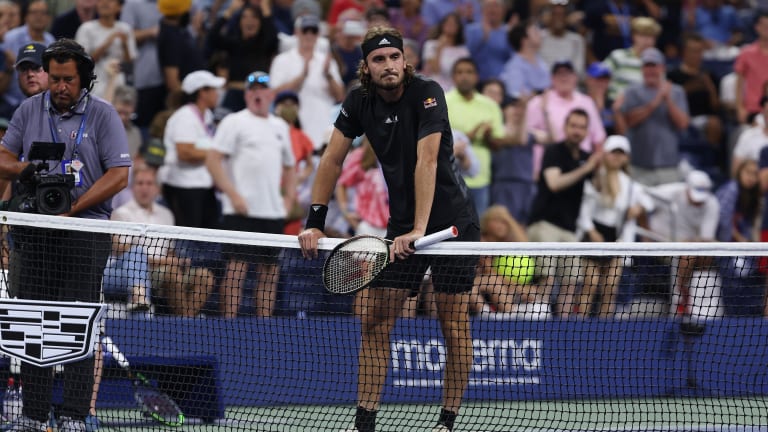
Stefanos Tsitsipas experienced another difficult loss at the US Open.
© Getty Images
Advertising
NEW YORK—The US Open has not been very kind recently to this year’s No. 4 seed, Stefanos Tsitsipas. On Monday night in Louis Armstrong Stadium, the event turned downright cruel. Daniel Elahi Galan, a lanky, stoic Colombian playing his first-ever main-draw match in Flushing Meadows, upset the Greek star despite failing to convert eight match points in the final set of the 6-0, 6-1, 3-6, 7-5 win.
“When he (Tsitsipas) started playing better in the third set I started to complain (to myself) a little more,” Galan reported in his on-court post-match interview. “But I told myself to calm down and then it was better.”
For Tsitsipas, the match must have been fraught with eerie overtones. Last year, he lost a fifth-set tiebreaker in the third round to rookie sensation Carlos Alcaraz. In 2020, he was beaten in similar fashion after squandering six match points in a bitter struggle with Borna Coric—the same player who upset Tsitsipas in the final of the recent Cincinnati Masters. Tsitsipas came into this tournament hot, with a tour-leading 46 wins this year.
Really tough to explain Tsitsipas' performance.
— José Morgado (@josemorgado) August 30, 2022
And summer.
And year.
Some great moment, some horrific ones.
Incredible moment for Galan and Colombia, though.
Osório won earlier today as well...
Advertising
Tsitsipas overcame a terribly slow start—he dropped the first 10 games—to win a tight, 6-3 third set. He appeared to have righted his ship in the fourth, using his whiplash forehand and ripping backhand to go up a break for 2-1. But Galan ultimately broke back to level the seat at 4-all. He then held serve for 5-4, at which point Tsitsipas lost the plot. Angry, seemingly confused, he fell behind 15-40—double match point—but fended off both, and then three more, to level the set at 5-apiece.
But Galan held his nerve, as well as his serve. He knocked at Tsitsipas’ door again in the next game, as Tsitsipas sprayed some costly errors between daring winners, staving off another three more match points. Galan finally converted his ninth match point when Tsitsipas overcooked a forehand by inches at Galan’s baseline.
“I'm more than happy to be here in New York,” Tsitsipas said on Friday. “I always feel like it has something new to offer. If you accidentally miss a street or don't use Google Maps, you might end up somewhere beautiful that you haven't seen before.”
Unfortunately for Tsitsipas, on Monday night in Queens he ended up in a place that must look all too familiar: on the wrong end of a shocking upset.—Peter Bodo
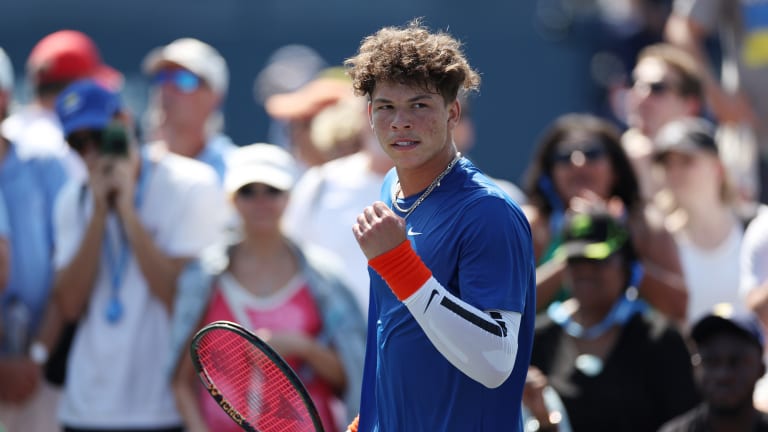
Ben Shelton's fanbase grew significantly on Monday, even in defeat.
© Getty Images
Advertising
Ben Shelton's First US Open Won't Be His Last
NEW YORK—Arthur Ashe Stadium is the place to be tonight, with The Serena Show and The Summer of Nick’s final acts about to commence. But Court 10 was the place to be this afternoon at Flushing Meadows, with 2022 NCAA singles champion Ben Shelton giving a raucous crowd a moment they won’t forget, and perhaps a taste of what’s to come in much larger venues.
Shelton, who just last week announced his decision to turn pro, was facing qualifier Nuno Borges (himself a former SEC star, at Mississippi State). While it was the 19-year-old Georgian’s Grand Slam debut, the atmosphere may have been old hat, given some of the heated dual matches he contested at the University of Florida. I kid, somewhat, but the energy generated in this tucked-away side court is what the early days of each US Open are about, and today Shelton was the reason why—even if he ultimately fell short.
Facing a Borges match point in the fourth-set tiebreak, Shelton held his nerve and survived. It was a tiebreak the Portuguese player probably should have wrapped up earlier, but Shelton and his rapidly expanding fanbase—99 percent of the excited patrons were surely watching him play for the first time—were thrilled to see this match head to a decider. It was loud, a mini Ben Hill Griffin Stadium up north.
Court 10 was as teeming as Nuno Borges was resilient; he recovers from a missed match point in the fourth-set tiebreak to defeat Ben Shelton. The just-turned-pro American had a memorable summer and was a side-court star today. #USOpen pic.twitter.com/YOKO1JwkJI
— Ed McGrogan (@EdMcGrogan) August 29, 2022
Advertising
While Shelton ultimately fell, 7-6 (6), 3-6, 7-6 (5), 6-7 (8), 6-3, his summer—which included a 6-3, 6-3, win over Casper Ruud in Cincinnati—ends on a decidedly upward trend. Expectations shouldn’t be set too high, too quickly, but the kid can pummel the ball, he covers the court like a gazelle, and he has an unmistakable charisma that sets him apart. There will be more trips to Flushing Meadows, though fans wanted to keep this particular moment going as long as possible.
On his walk back to the locker room, some sprinted to seek Shelton’s signature and approach him for post-match selfies—be obliged with one orange-and-blue Gators supporters. Security thankfully kept things civil, allowing the youngster be with his thoughts after an admirable afternoon. But one friend of Shelton’s stopped him before he arrived to give him a congratulatory handshake, and to let him know, appreciatively, that this was only his “first time.”
It certainly won’t be his last.—Ed McGrogan
Outer courts boasting New York Minute conditions in Flushing
NEW YORK—Much was made over the US Open’s conditions heading into the tournament, primarily due to the tournament's lighter women’s ball drawing ire from the likes of top seeds Iga Swiatek and Paula Badosa.
Once play got underway, however, it became apparent that the balls weren’t the only elements encouraging quicker play.
“It’s super-fast,” Camila Osorio exclaimed of the courts after her three-set victory over American Ann Li. “Super super fast. But we have to get used to the conditions. It’s like every week is different!”
Within the first 40 minutes of play, most matches had completed one set, and things haven’t slowed much as Monday’s action continued.
“It was fast, obviously with the heat and humidity out, it makes the ball travel pretty fast through the air,” admitted No. 5 seed Casper Ruud after his straight-set win over Kyle Edmund. “It makes the serves faster and with a little bit lower bounces.”
Advertising
Court 12 was faster than other courts I practiced on; it’s one of the outside courts and not maybe what you would call one the stadium courts. I have been practicing a little bit on Grandstand leading up to the tournament, and that was a little bit slower, in my opinion. Casper Ruud
But not everyone was convinced about the unfolding phenomenon.
“I didn't find it any different to any other US Open the years before,” said Maria Sakkari, who advanced on Grandstand over Wimbledon semifinalist Tatjana Maria.
Top seed Daniil Medvedev co-signed Sakkari’s assessment after kicking off his title defense by defeating American Stefan Kozlov.
“For me US Open was always quick,” he said in press. “The only time I felt it a little bit slow when I came here for qualies, but I didn't have yet the opportunity to play on the biggest stages of the world, so every court I had been playing was pretty fast because many Challenger, Futures are played on fast surfaces. We were playing at night. I felt like it was super slow. I guess it was the wrong feeling.”
Ruud theorizes the show courts, where Sakkari and Medvedev played, are a more stable speed, where the outer courts pose more changeable conditions.
“Court 12 was faster than other courts I practiced on; it’s one of the outside courts and not maybe what you would call one the stadium courts,” he said. “I have been practicing a little bit on Grandstand leading up to the tournament, and that was a little bit slower, in my opinion. But that’s how it is, and I think I was able to adjust quite well. It wasn’t the greatest start, but I was able to raise my level and get the groove going on the court and in these conditions.”
The disparate conditions may increase the importance of court assignments, particularly in the early stages as players like Ruud may continue to be relegated to outer courts in favor of more established names.—David Kane
Advertising
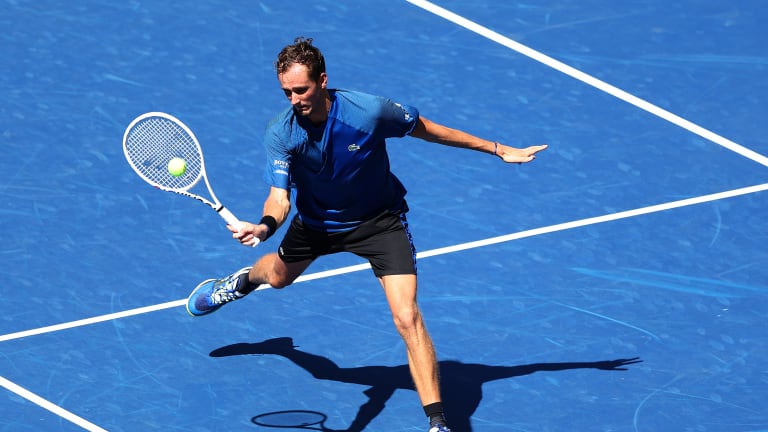
How quickly are the US Open courts playing? Court assignments may make the difference with outer courts likely playing faster than the stadiums.
© Getty Images
In 'The World’s Borough', the US Open is everyone’s home Slam
NEW YORK—When players cross the Midtown Tunnel, they are met with road signs welcoming them to “The World’s Borough.” With nearly 48 percent of its residents born abroad, Queens is the most diverse county in the entire United States, and its main artery, the 7 subway line—which runs between Manhattan and Flushing—is nicknamed the “International Express.”
Nowhere is that diversity more evident than at the US Open, where New York City’s international residents and visitors passionately support their own—creating a jarring clash for the home hopefuls.
Colombia’s Camila Osorio knows this well, as her own dedicated fans packed the stands on Court 13 in bright yellow national team jerseys. Amid cries of “Tú puedes, Cami!” (“You can do it, Cami”) and “Vamos Colombia!” (“Come on Colombia!”), the 20-year-old rallied for a 1-6, 6-3, 6-1 win over American Ann Li.
“When I stepped onto the court and people started cheering, it was really, really nice,” Osorio told TENNIS.com. “I love playing here in New York because I know there [are] a lot of Colombian fans. It’s always super nice to have them and to feel their energy, and it’s on every point.”
Advertising
¡GRITALO FUERTE CAMILA! 🇨🇴🙌
— ESPN Tenis (@ESPNtenis) August 29, 2022
En su debut en el #USOpen, la colombiana Osorio fue de menos a más para vencer por 1-6, 6-3 y 6-1 a la local 🇺🇸 Ann Li y quedarse con el boleto a la segunda ronda.
🔜 La estadounidense Riske será su próxima rival. pic.twitter.com/o0prfbvSFK
Being on the other side of that atmosphere can be a brutal experience. Unlike the Australian Open, Roland Garros and Wimbledon, where fan support for homegrown talent can often reach an almost jingoistic fever pitch during matches, the US Open is uniquely the opposite—to the perpetual chagrin of the American contingent.
In 2013, John Isner was “disappointed” at the US Open crowd’s loud support for fan favorite Gael Monfils, telling press, "If I was playing in France, it certainly wouldn't be like that."
That sentiment was echoed by Tommy Paul in a recent pre-tournament interview: “Sometimes you can get a little salty if you’re at your home Slam and you’re playing someone from Spain and they’re all cheering for him,” he said. “It’s like, ‘What’s going on?’”
But in ‘The World’s Borough', the US Open is everyone’s home Slam. As Osorio put it: “It’s a different kind of tournament. This tournament is super special, for every player.”—Stephanie Livaudais
Advertising
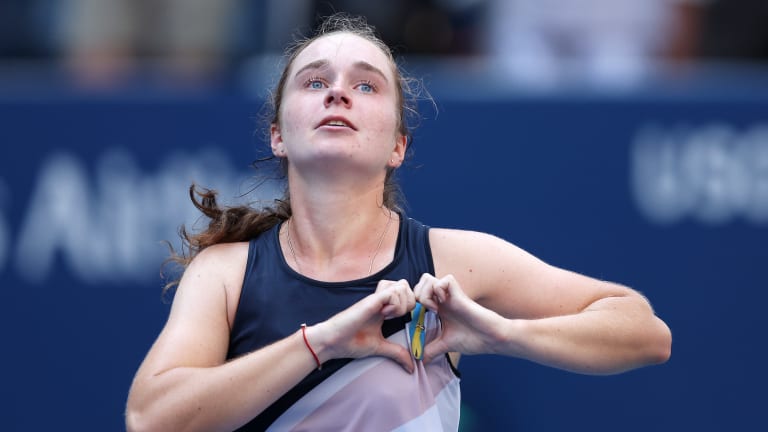
Daria Snigur earned an emotional victory over former world No. 1 Simona Halep on Louis Armstrong Stadium, where she played last week as part of Tennis Plays for Peace.
© Getty Images
Playing for Ukraine, Daria Snigur stops title favorite Halep
NEW YORK—The wide-open women’s field held few certainties, save perhaps that former world No. 1 Simona Halep had a significant shot at winning her first US Open title. The former Roland Garros and Wimbledon champion has never played her best in New York, losing back-to-back first rounders when she was a Top 2 player in 2017 and 2018. But she arrived to Flushing Meadows this year having won her 24th career title in Canada, and seemingly sat at the apex of experienced and in-form.
Enter qualifier Daria Snigur, who took her first turn on Louis Armstrong Stadium last week when she participated in Tennis Plays for Peace, an exhibition event held in support of Ukraine. The Kyiv-born 20-year-old previously tasted Grand Slam glory at junior Wimbledon in 2019, but she had never played the main draw of a pro-level major until Monday, after winning three matches in qualifying.
Taking advantage of the quick courts, her flat hitting nonetheless left Halep stumped for much of the match, and though the Romanian rallied in some style in the second set, Snigur was unmoved as she raced ahead 5-1 in the decider.
On the brink of not only her first Top 10 victory but also her first win on the tour level, Snigur nearly froze, missing two match points as Halep broke the youngster in her first attempt at serving for the match, and edged ahead 0-30 in her second.
That’s as far as Halep would go: Snigur secured the next four points to clinch an emotional 6-2, 0-6, 6-4 victory, punctuated by her pointing to a Ukraine-flag ribbon on her chest, which she framed in a heart with her hands.
Advertising
Take it in, Daria Snigur!
— US Open Tennis (@usopen) August 29, 2022
What a moment 😍 pic.twitter.com/Of6TV1MDjt
Crediting the Ukraine exo with helping her acclimate to this major stage, Snigur thanked fans on Armstrong and at home for the support she’ll need if she hopes to continue this impressive run in the second round against either Rebecca Marino or Magdalena Freçh. But wow, what a moment she will never forget.—David Kane
Advertising
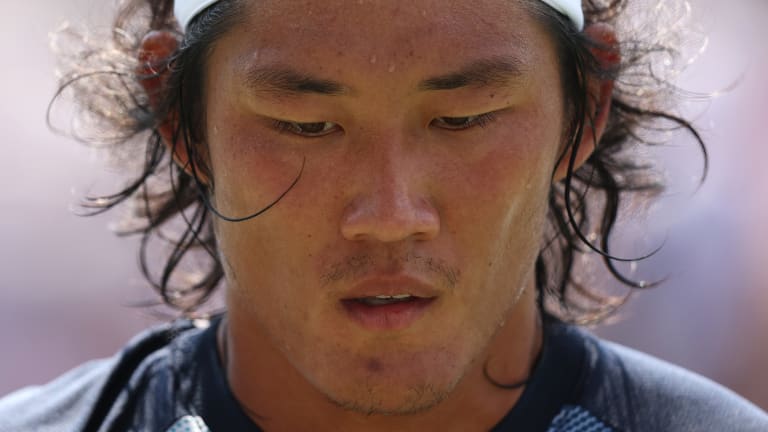
Zhizhen Zhang was bidding to become the first Chinese man to win a US Open main-draw match.
© Getty Images
Seven Match Points Not Enough For Zhizhen Zhang
NEW YORK—The second “7” in Tim van Rijthoven’s 3-6, 6-7 (4), 7-6 (9), 6-1, 6-4 win over Zhizhen Zhang meant more than just the tiebreak he won in order to stay alive. It also, incredibly, represented the seven match points he saved in that set.
You read that right.
The statistic may be as unlikely as the 25-year-old’s emergence this summer, which saw him win his first ATP-level match in s’-Hertogenbosch—and then win seven more matches, plus a set over Novak Djokovic, before falling to the all-time great at Wimbledon.
Regardless, van Rijthoven now has an all-time great comeback story to tell.
After using seven of his nine lives, the cat-like Dutchman lost just five more games on Court 6. The teeming side court (see our earlier post on J.J. Wolf) drew onlookers for this match's stunning turn, but also for Zhizhen, the qualifier who was bidding to become the first Chinese man to win a US Open main-draw match.
In heartbreaking fashion, Zhizhen couldn't secure that distinction, though it would come to pass elsewhere on the grounds, when Yibing Wu defeated Nikoloz Basilashvili in far less dramatic fashion, 6-3, 6-4, 6-0.—Ed McGrogan
Advertising
History for 🇨🇳!
— US Open Tennis (@usopen) August 29, 2022
Yibing Wu becomes the first Chinese man to win a #USOpen singles match. pic.twitter.com/RgGktQt4Wd
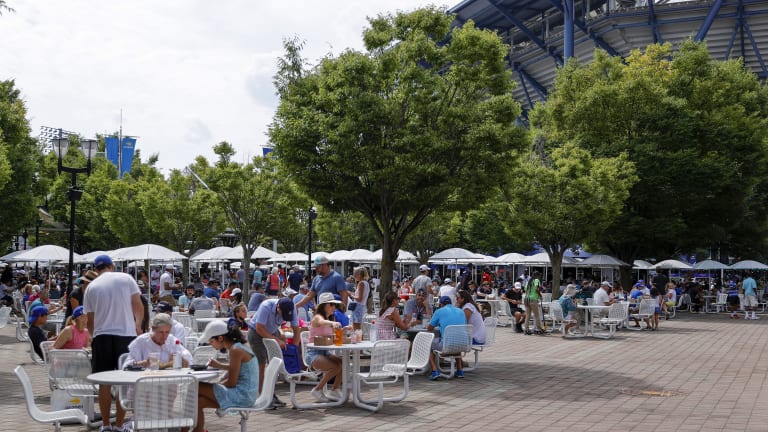
No US Open visit would be complete without a trip to its famed Food Village.
© Getty Images
Advertising
A Twist in Dough
NEW YORK—Day 1 at the US Open, personified in the shape of that twisted, breaded, salted doughy item also known as a New York pretzel. Forty-four years ago, on opening day of the first US Open played at Flushing Meadows, my friend Mike and I arrived at the US Open for the first time, the last leg of our cross-country drive from Los Angeles. There was a pretzel that day too, chewed as we squeezed through a crowd to watch Jimmy Connors practice.
Since then, it’s my opening-day tradition (well, one of them). Now today, with the temperature a sticky 82 degrees, the craving for the pretzel is underway. Stand now near the fountain and the big video screen, showcasing three courts—2019 US Open champion Bianca Andreescu in control versus Harmony Tan until she isn’t, American Sebastian Korda in a tight one against qualifier Facundo Bagnis, 2016 US Open winner Stan Wawrinka still zinging his backhand, today against lucky loser Corentin Moutet (alas, Stan would retire). But the pursuit of the pretzel must continue.
Head south and gaze at Court 14—No. 30 seed Maxime Cressy. Back when I first surfaced here in 1978, net-rushers like him were the rule. Now, Cressy’s an outlier, but skilled at it well enough to currently be frustrating world No. 98 Marton Fucsovics. Just to the west, on 13, No. 31 seed Nikoloz Basilashvili is struggling versus qualifier Yibing Wu.
In line at the Kosher Grill. At last, the pretzel, mostly doughy, reasonably salted, mildly crisp, splatted with mustard. Back now through thick crowds, headed in all directions. A few of the pros, carrying their racquet bags, headed to practice. The pretzel has lasted seven minutes. Other US Open rituals to follow.—Joel Drucker
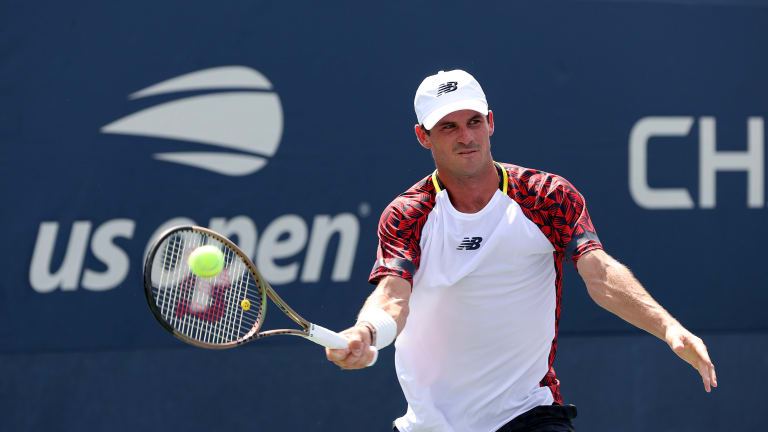
Paul rallied from two sets to one to defeat Bernabe Zapata Miralles in his first Grand Slam as a Top 32 seed.
© Getty Images
Advertising
In Court 11 tussle, Tommy Paul survives in five
“Tommy Paul!” a male fan in the audience yelled as the 25-year-old American walked off Court 11 a five-set winner over Bernabe Zapata Miralles on Monday. There was no emcee on that side court, no one to announce Paul’s departure, so the fan decided to do the job himself. The rest of the audience took his cue and ushered Paul out with a rousing cheer.
There were Americans everywhere on the grounds on this opening day. There are 44 in the singles draws, and their presence brought a more enthusiastic energy to the big crowds who watched them. But a loss by Paul, who is seeded 29th and has had one of the most promising seasons of any U.S. player, would have been a buzzkill. Despite Zapata Miralles’ low-70s ranking, the Spaniard is a tough out and gritty baseliner. He won the first and third sets, before Paul won the fourth 6-0 and seemed to finally have everything under control at 5-4 in the fifth.
All he had to do was serve it out. Nothing to it, right? Instead, Paul proceeded to double fault, hesitate and miss an easy forehand, throw in a wild serve-and-volley attempt, and get broken. “That’s OK, Tommy,” someone yelled, and maybe the support helped. As quickly as Paul was broken, he broke back. When he served for it again at 6-5, he made it look easy, firing off two forehand winners for the victory.
Survival is the goal in the first round, and Paul had survived—nothing more, nothing less.—Steve Tignor
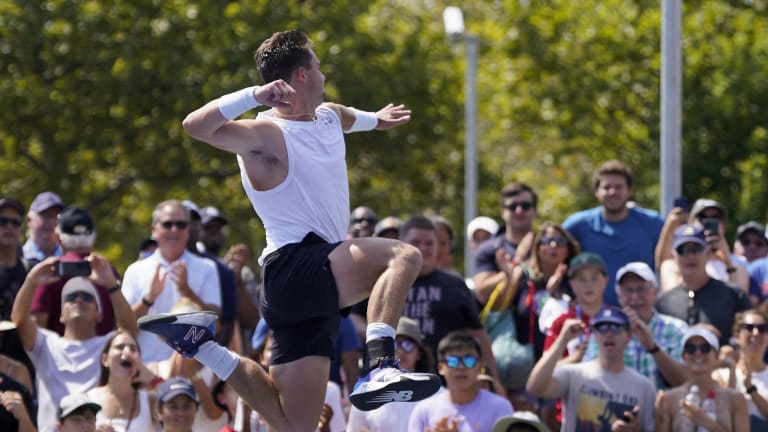
Wolf stayed composed throughout his straight-set win before sharing a celebration with the Court 5 crowd after.
© AP
Advertising
J.J. Wolf leaps into the second round
NEW YORK—Sweaty; crowded; loud. These adjectives accurately describe the 4-5-6 in New York City, whether you’re referring to the much-maligned Lexington Avenue subway line, or the trio of side courts, abutting each other like passengers during morning rush hour, at the USTA Billie Jean King National Tennis Center.
On opening day of the 2022 US Open, Courts 4, 5 and 6 were extra sweaty (thanks to humid conditions with temperatures in the mid-80s), extra crowded (thanks to palpable Day 1 excitement and a strong early schedule) and extra loud. You can thank J.J. Wolf for the latter.
Show the vertical, JJ Wolf!
— US Open Tennis (@usopen) August 29, 2022
Plenty to celebrate for the 🇺🇸 pic.twitter.com/wEKV9W27Y4
Advertising
Wolf, whose mullet is gone but whose mustache remains, bears resemblance to rising WWE star Theory, and the muscular 23-year-old earned his pops on Monday. His 6-4, 6-4, 6-4 upset of 16th seed Roberto Bautista Agut was a masterclass in hard-court tennis, Wolf using his well-stocked arsenal to keep the 2019 Wimbledon semifinalist off the baseline and constantly scrambling on this sweltering afternoon. He served aggressively, winning 88 percent of his first-serve points, including 14 aces (he also struck three double faults), and he never allowed the cagey Spanish veteran to dictate play.
Bautista Agut did well to hold serve from 30-30 while trailing 3-4 in the third, and he earned break points in Wolf’s next service game. But with the crowd firmly in his corner—of the cacophony of sounds “Let’s go J.J.” chants were the loudest—Wolf remained resolute, and closed out the contest with a love hold. Then he punctuated it with a leaping fist-pump:
Coming off a third-set tiebreaker loss to Dominic Thiem in Winston-Salem, in which Wolf held two match points, the American was looking to turn the page in New York. Wolf did just that, and like Theory, he was money in the bank.—Ed McGrogan